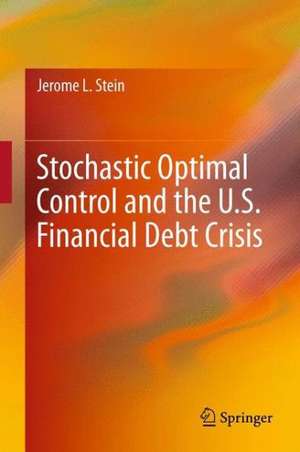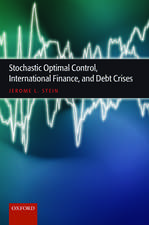Stochastic Optimal Control and the U.S. Financial Debt Crisis
Autor Jerome L. Steinen Limba Engleză Paperback – 13 apr 2014
| Toate formatele și edițiile | Preț | Express |
|---|---|---|
| Paperback (1) | 414.42 lei 43-57 zile | |
| Springer – 13 apr 2014 | 414.42 lei 43-57 zile | |
| Hardback (1) | 388.52 lei 43-57 zile | |
| Springer – 30 mar 2012 | 388.52 lei 43-57 zile |
Preț: 414.42 lei
Nou
Puncte Express: 622
Preț estimativ în valută:
79.30€ • 83.02$ • 65.61£
79.30€ • 83.02$ • 65.61£
Carte tipărită la comandă
Livrare economică 07-21 aprilie
Preluare comenzi: 021 569.72.76
Specificații
ISBN-13: 9781489986313
ISBN-10: 1489986316
Pagini: 176
Ilustrații: XVI, 160 p.
Dimensiuni: 155 x 235 x 15 mm
Greutate: 0.25 kg
Ediția:2012
Editura: Springer
Colecția Springer
Locul publicării:New York, NY, United States
ISBN-10: 1489986316
Pagini: 176
Ilustrații: XVI, 160 p.
Dimensiuni: 155 x 235 x 15 mm
Greutate: 0.25 kg
Ediția:2012
Editura: Springer
Colecția Springer
Locul publicării:New York, NY, United States
Public țintă
Professional/practitionerCuprins
Introduction/preface .- Failure of the Fed, IMF, academic profession to anticipate the crisis, disregarded warnings.- Failure of the Quants, mathematical finance models.- Philosophy of Stochastic optimal control approach, relation to M-V analysis; Sensitivity of optimal debt and risk to alternative stochastic processes, Early Warning Signals.- Application of Stochastic Optimal Control to Financial crisis 2007-08.- AIG in the crisis.- Crises in the 1980s: Agricultural, S&L.- Diversity of debt crises in Euro.
Recenzii
From the reviews:
“This book is another piece in recent literature that proposes an early warning system (EWS). … this book serves well as a ‘handbook of selected financial crises’ for those who want to understand better the two recent big crises, the 2008 U.S. crisis and the ongoing Eurozone one. This book is an easy read with minimal mathematics … and ample figures, tables, quotes, and references. Each chapter has its own abstract and references. This makes each chapter individually readable … .” (Youngna Choi, Mathematical Reviews, March, 2013)
“Stein has written a timely book on the financial crisis emanating from the collapse of the U.S. mortgage market, as well as on the European financial crisis. … It should appeal both to economists and mathematicians interested in how SOC techniques could have been used to provide early warning signals of the recent crises, as well as to those interested in risk management. … the book should also be read by policy makers.” (Peter Clark, Kredit und Kapital, Vol. 45 (2), 2012)
“This book is another piece in recent literature that proposes an early warning system (EWS). … this book serves well as a ‘handbook of selected financial crises’ for those who want to understand better the two recent big crises, the 2008 U.S. crisis and the ongoing Eurozone one. This book is an easy read with minimal mathematics … and ample figures, tables, quotes, and references. Each chapter has its own abstract and references. This makes each chapter individually readable … .” (Youngna Choi, Mathematical Reviews, March, 2013)
“Stein has written a timely book on the financial crisis emanating from the collapse of the U.S. mortgage market, as well as on the European financial crisis. … It should appeal both to economists and mathematicians interested in how SOC techniques could have been used to provide early warning signals of the recent crises, as well as to those interested in risk management. … the book should also be read by policy makers.” (Peter Clark, Kredit und Kapital, Vol. 45 (2), 2012)
Notă biografică
Jerome L. Stein has been an emeritus professor of economics at Brown University since 1993, and has served as a visiting professor of applied mathematics since 1997. He is the author of nine research monographs, and has published over 100 journal articles in such leading publications as American Economic Review, Review of Economics and Statistics, Journal of Banking and Finance, and Contemporary Mathematics. He has served on the editorial boards of the Journal of Finance, American Economic Review, Journal of International and Comparative Economics, and the Journal of Banking and Finance.
Textul de pe ultima copertă
Stochastic Optimal Control (SOC)—a mathematical theory concerned with minimizing a cost (or maximizing a payout) pertaining to a controlled dynamic process under uncertainty—has proven incredibly helpful to understanding and predicting debt crises and evaluating proposed financial regulation and risk management. Stochastic Optimal Control and the U.S. Financial Debt Crisis analyzes SOC in relation to the 2008 U.S. financial crisis, and offers a detailed framework depicting why such a methodology is best suited for reducing financial risk and addressing key regulatory issues. Topics discussed include the inadequacies of the current approaches underlying financial regulations, the use of SOC to explain debt crises and superiority over existing approaches to regulation, and the domestic and international applications of SOC to financial crises. Principles in this book will appeal to economists, mathematicians, and researchers interested in the U.S. financial debt crisis and optimal risk management.
Jerome L. Stein has been an emeritus professor of economics at Brown University since 1993, and has served as a visiting professor of applied mathematics since 1997. He is the author of nine research monographs, and has published over 100 journal articles in such leading publications as American Economic Review, Review of Economics and Statistics, Journal of Banking and Finance, and Contemporary Mathematics. He has served on the editorial boards of the Journal of Finance, American Economic Review, Journal of International and Comparative Economics, and the Journal of Banking and Finance.
Jerome L. Stein has been an emeritus professor of economics at Brown University since 1993, and has served as a visiting professor of applied mathematics since 1997. He is the author of nine research monographs, and has published over 100 journal articles in such leading publications as American Economic Review, Review of Economics and Statistics, Journal of Banking and Finance, and Contemporary Mathematics. He has served on the editorial boards of the Journal of Finance, American Economic Review, Journal of International and Comparative Economics, and the Journal of Banking and Finance.
Caracteristici
Cutting-edge interdisciplinary research in the areas of finance, economics, and applied statistics and mathematics First comprehensive text on using stochastic optimal control to predict financial debt crises Offers analytical tools to explain and evaluate trends in risk management, and provides theoretically-based warning signals of currency and debt crises Shows how stochastic optimal control could have been used to mitigate collapses in various U.S. financial sectors, including housing and insurance












